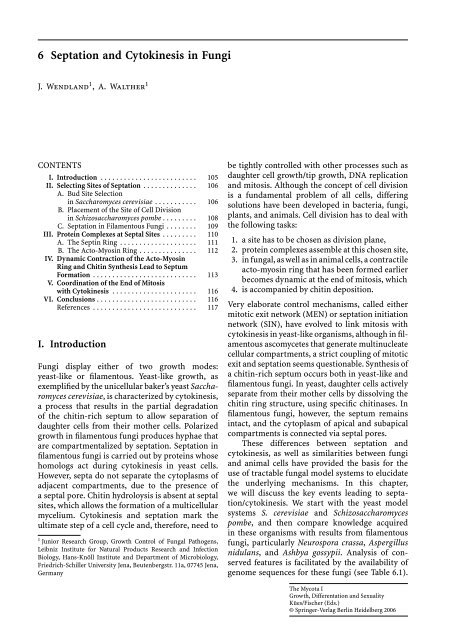Growth, Differentiation and Sexuality
Growth, Differentiation and Sexuality
Growth, Differentiation and Sexuality
Create successful ePaper yourself
Turn your PDF publications into a flip-book with our unique Google optimized e-Paper software.
6 Septation <strong>and</strong> Cytokinesis in Fungi<br />
J. Wendl<strong>and</strong> 1 ,A.Walther 1<br />
CONTENTS<br />
I. Introduction ......................... 105<br />
II. Selecting Sites of Septation .............. 106<br />
A. Bud Site Selection<br />
in Saccharomyces cerevisiae ........... 106<br />
B. Placement of the Site of Cell Division<br />
in Schizosaccharomyces pombe ......... 108<br />
C. SeptationinFilamentousFungi........ 109<br />
III. Protein Complexes at Septal Sites ......... 110<br />
A. TheSeptinRing .................... 111<br />
B. TheActo-MyosinRing............... 112<br />
IV. Dynamic Contraction of the Acto-Myosin<br />
Ring <strong>and</strong> Chitin Synthesis Lead to Septum<br />
Formation ........................... 113<br />
V. Coordination of the End of Mitosis<br />
with Cytokinesis ...................... 116<br />
VI. Conclusions .......................... 116<br />
References ........................... 117<br />
I. Introduction<br />
Fungi display either of two growth modes:<br />
yeast-like or filamentous. Yeast-like growth, as<br />
exemplified by the unicellular baker’s yeast Saccharomyces<br />
cerevisiae, is characterized by cytokinesis,<br />
aprocessthatresultsinthepartialdegradation<br />
of the chitin-rich septum to allow separation of<br />
daughter cells from their mother cells. Polarized<br />
growth in filamentous fungi produces hyphae that<br />
are compartmentalized by septation. Septation in<br />
filamentous fungi is carried out by proteins whose<br />
homologs act during cytokinesis in yeast cells.<br />
However, septa do not separate the cytoplasms of<br />
adjacent compartments, due to the presence of<br />
a septal pore. Chitin hydroloysis is absent at septal<br />
sites, which allows the formation of a multicellular<br />
mycelium. Cytokinesis <strong>and</strong> septation mark the<br />
ultimate step of a cell cycle <strong>and</strong>, therefore, need to<br />
1 Junior Research Group, <strong>Growth</strong> Control of Fungal Pathogens,<br />
Leibniz Institute for Natural Products Research <strong>and</strong> Infection<br />
Biology, Hans-Knöll Institute <strong>and</strong> Department of Microbiology,<br />
Friedrich-Schiller University Jena, Beutenbergstr. 11a, 07745 Jena,<br />
Germany<br />
be tightly controlled with other processes such as<br />
daughter cell growth/tip growth, DNA replication<br />
<strong>and</strong> mitosis. Although the concept of cell division<br />
is a fundamental problem of all cells, differing<br />
solutions have been developed in bacteria, fungi,<br />
plants, <strong>and</strong> animals. Cell division has to deal with<br />
the following tasks:<br />
1. a site has to be chosen as division plane,<br />
2. protein complexes assemble at this chosen site,<br />
3. in fungal, as well as in animal cells, a contractile<br />
acto-myosin ring that has been formed earlier<br />
becomes dynamic at the end of mitosis, which<br />
4. is accompanied by chitin deposition.<br />
Very elaborate control mechanisms, called either<br />
mitotic exit network (MEN) or septation initiation<br />
network (SIN), have evolved to link mitosis with<br />
cytokinesis in yeast-like organisms, although in filamentous<br />
ascomycetes that generate multinucleate<br />
cellular compartments, a strict coupling of mitotic<br />
exit <strong>and</strong> septation seems questionable. Synthesis of<br />
a chitin-rich septum occurs both in yeast-like <strong>and</strong><br />
filamentous fungi. In yeast, daughter cells actively<br />
separate from their mother cells by dissolving the<br />
chitin ring structure, using specific chitinases. In<br />
filamentous fungi, however, the septum remains<br />
intact, <strong>and</strong> the cytoplasm of apical <strong>and</strong> subapical<br />
compartments is connected via septal pores.<br />
These differences between septation <strong>and</strong><br />
cytokinesis, as well as similarities between fungi<br />
<strong>and</strong> animal cells have provided the basis for the<br />
use of tractable fungal model systems to elucidate<br />
the underlying mechanisms. In this chapter,<br />
we will discuss the key events leading to septation/cytokinesis.<br />
We start with the yeast model<br />
systems S. cerevisiae <strong>and</strong> Schizosaccharomyces<br />
pombe, <strong>and</strong> then compare knowledge acquired<br />
in these organisms with results from filamentous<br />
fungi, particularly Neurospora crassa, Aspergillus<br />
nidulans, <strong>and</strong> Ashbya gossypii. Analysis of conserved<br />
features is facilitated by the availability of<br />
genome sequences for these fungi (see Table 6.1).<br />
The Mycota I<br />
<strong>Growth</strong>, Differentation <strong>and</strong> <strong>Sexuality</strong><br />
Kües/Fischer (Eds.)<br />
© Springer-Verlag Berlin Heidelberg 2006

















